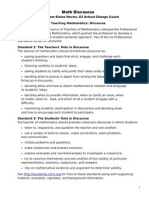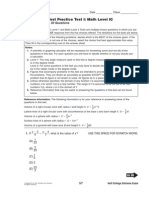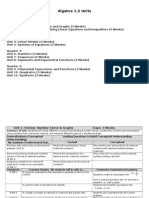Module 3 - Problem Solving and Reasoning
Uploaded by
Jala, Jan Kylle B.Module 3 - Problem Solving and Reasoning
Uploaded by
Jala, Jan Kylle B.Mathematics FINALS
CDU – CN
MATH / Lecture / First Semester
Module 3: Problem Solving and Reasoning
*From the data, we find that the resulting number is 5
Topic Outline times the original number or 5n.
3.1 Inductive Reasoning Any counterexamples? Let’s try numbers 0, -1, -2
3.2 Deductive Reasoning
3.3 Inductive and Deductive Sample Problems 1. Pick a number 0 -1 -2
3.4 Polya’s Problem Solving Strategies 2. Multiply the number by 10 0 -10 -20
3. Add 8 to the product 8 -2 -12
4. Divide the sum by 2 4 -1 -6
3.1 INDUCTIVE REASONING 5. And subtract 4 0 -5 -10
Inductive Reasoning - reasoning that uses specific *From the data, we find that there are no
examples (cases) to reach a general conclusion counterexamples because the resulting numbers still
Conjecture - the conclusion derived from inductive follows the pattern 5n.
reasoning
o a conjecture is an idea that may or may not Example 3: Given the data in a table, answer the
be correct questions using inductive reasoning.
Counterexample – situation/cases that refutes or
disagrees a conjecture Earthquake Tsunami Maximum
Magnitude Height (meters)
7.5 5
Specific 7.6 9
Cases
7.7 13
7.8 17
Pattern 7.9 21
8.0 25
General Principle 8.1 29
*From the data, we find that for every 0.1 difference of
EXAMPLES OF INDUCTIVE REASONING
earthquake magnitude, there is an increase of 4
meters in the maximum height of tsunami.
Example 1: Use inductive reasoning to predict the
next number in each of the following list. 1. If the earthquake is 8.2, what is the maximum height
a. 5, 10, 15, 20, 25, ___? of the tsunami? 29 + 4 = 33 m
- as observed, each number increases by 5
units, thus, the next number is 30 (i.e., 25 + 5 = 2. If the earthquake’s magnitude is 7.0, will a tsunami
30) occur? No
- each number are multiples of 5
b. 1, 4, 9, 16, 25, ____? Example 4:
- as observed, each number are perfect I own an orange fish.
squares such that the next number is 36 (i.e, My friend owns an orange fish.
62 = 36) Therefore, all fish are orange.
Example 5:
Example 2: Use inductive reasoning to make a
The last six times we played our archrival in
conjecture of the given process.
football, we won, so I know we’re going to win on
Saturday.
1. Pick a number 4 7 8
2. Multiply the number by 10 40 70 80
3. Add 8 to the product 48 78 88
4. Divide the sum by 2 24 39 44
5. And subtract 4 20 35 40
Problem Solving and Reasoning | 1
Mathematics FINALS
CDU – CN
MATH / Lecture / First Semester
Module 3: Problem Solving and Reasoning
3.2 DEDUCTIVE REASONING 3.3 INDUCTIVE AND DEDUCTIVE SAMPLE PROBLEMS
Deductive Reasoning - reasoning that uses general Direction: Read and understand the given
assumptions, principles and procedures to reach a statements. Identify which type of reasoning can be
conclusion used.
1. 3, 6, 9, 12, 15, ___? What is the next number?
General Principle o The next number is 8
o Inductive reasoning
Pattern
2. If 𝑥 > 0, then 1/x > 0. True or False?
Specific o True
Cases o Deductive reasoning
3. 1, 3, 6, 10, 15, ___? What is the next number?
o The next number is 21
EXAMPLES OF DEDUCTIVE REASONING o Inductive reasoning
2
Example 1: 4. x is always positive. True or False?
o The sum of two odd integers is an even o True, provided that x is not equal to zero
integer. o Deductive reasoning
o m and n are odd integers.
o Thus, m + n is even. 5. The multiplicative inverse of 1/x always exists. True
or False?
Example 2: o True, provided that x is not equal to zero
o In a right triangle, the two acute angles are o Deductive reasoning
complementary.
o Triangle ABC has B = 90O. 3.4 POLYA’S PROBLEM-SOLVING STRATEGIES
o Therefore, A + C = 90O.
POLYA’S FOUR-STEP PROBLEM SOLVING PROCESS
Example 3: Use deductive reasoning to make a
conjecture of the given process. STEP 1 – UNDERSTAND THE PROBLEM
1. Pick a number n
Can you restate the problem in your own words?
2. Multiply the number by 10 10n
Can you determine what is known about these types
3. Add 8 to the product 10n + 8 of problems?
4. Divide the sum by 2 10n + 8/ 2 = 5n + 4 Is there missing information that, if known, would
5. And subtract 4 5n + 4 – 4 = 5n allow you to solve the problem?
Is there extraneous information that is NOT needed
Example 4: to solve the problem?
There is no mail delivery on holidays. What is the goal?
Tomorrow is thanksgiving, so I know my student loan
check won’t be delivered. STEP 2 – DEVISE A PLAN
Example 5: Make a list of the known information.
All vegetables are purple. Make a list of information that is needed.
Lettuce is a vegetable, so we know that lettuce is Draw a diagram.
purple. Make an organized list that shows all the
possibilities.
Make a table or chart.
Work backwards.
Try to solve similar but simpler problems.
Look for a pattern.
Problem Solving and Reasoning | 2
Mathematics FINALS
CDU – CN
MATH / Lecture / First Semester
Module 3: Problem Solving and Reasoning
Write an equation. If necessary, define what each
variable represents. Step 4 – Review the Solution
Perform an experiment.
Guess at a solution and check the result. o Φ = a + b/ a
1.618 = (1.2135 m + 0.75 m) / 1.2135 m
STEP 3 – CARRY OUT THE PLAN 1.618 = 1.9535 m / 1.2135 m
1.618 = 1.618
Work carefully.
Keep an accurate and neat record of all your EXAMPLE 2
attempts.
Realize that some of your initial plans will not work 2. Leonardo da Vinci was famous artist during the
and that there may be a need to devise another plan renaissance period. He wrote in his book that “from the
or modify your existing plan. top to the bottom of the chin is the sixth part of the
face, and it is the fifty-fourth part of the man”.
STEP 4 – REVIEW THE SOLUTION Suppose the distance from the top to the bottom of the
chin of a person is 1.2 inches. Fin the height of the
Ensure that the solution is consistent with the facts person
of the problem.
Interpret the problem in the context of the problem. Step 1 – Understand the Problem
Ask yourself whether there are generalizations of
the solution that could apply to other problems. o Determine the height of a person in which the
top to the bottom of the chin is the sixth part
EXAMPLES USING POLYA’S METHOD of the face, and it is the fifty fourth part of the
person and the distance from the top to the
EXAMPLE 1 bottom of the chin is 1.2 inches.
1. A wooden board is 0.75 meters wide. How long Step 2 – Devise a Plan
should you cut such that the Golden Ratio is observed?
Use 1.618 as the value of the Golden Ratio o Let x be the distance from the top to the
bottom of the chin which is 1.2 inches. Let y be
Step 1 – Understand the Problem the rank of the part of the top to the bottom of
the chin in the person which rank 54 th. Let h be
o A wooden board is 0.75 meters wide. The the height of the person.
problem is to determine the length such that o Use the equation h = xy
the golden ratio is observed
Step 3 – Carry Out the Plan
Step 2 – Devise a Plan
o h = xy
o Φ = a/b = a + b/a in calculating the golden h = (1.2 inches)(54)
ratio, to identify the length of the wooden h = 64.8 inches or 164.59 cm
board. o Therefore, the height of the person is 64.8
o Where Φ = 1.618, b = 0.75 m; which is the inches.
smaller side
Step 4 – Review the Solution
Step 3 – Carry Out the Plan
o Find x
o Φ = 1.618, b = 0.75 m h = xy
Φ = a/b x = h/y
1.618 = a/0.75m x = 64.8 inches/54
(1.618)(0.75) = a x = 1.2 inches
a = 1.2135 m o Find y
o Therefore, the length of the wooden board is h = xy
1.2135 m such that the golden ratio is y = h/x
observed. y = 64.8 inches/1.2 inches
y = 54
Problem Solving and Reasoning | 3
Mathematics FINALS
CDU – CN
MATH / Lecture / First Semester
Module 3: Problem Solving and Reasoning
EXAMPLE 3 o We will use this equation:
3. An agency charged 15,000 pesos for a 3D2N tour in ₱20,000 (x) + ₱15,000 (y) = ₱170,000
Macau and 20,000 pesos for the same tour with a (total charge)
side trip to Hong Kong. Ten persons join the trip with a
total package of 170,000 pesos. How many tourists ₱20,000 (4) + ₱15,000 (6) = ₱170,000
made a side trip to Hong Kong?
₱170,000 = ₱170,000
Step 1 – Understand the Problem
o A tour in Macau costs ₱15,000 without a side ~ END OF MODULE 1 ~
trip and ₱20,000 with a side trip to Hong
Trans by: Jan Kylle Jala BSN 1-I
Kong. A total of 10 persons joined the trip.
Thus, the agency got a total charge of
₱170,000. The problem is to determine the
number of tourists that made a side trip to
Hong Kong.
Step 2 – Devise a Plan
o Let x, be the number of tourists that made a
side trip to Hong Kong and y, be the number of
tourists that didn’t make a side trip.
o Given that information, we arrived with the
following equations:
x + y = 10 (total number of tourists)
o Let us first find the value of y:
Equation 1: x + y = 10; y = 10 – x
o Then, we can now substitute the given values
to this equation:
Equation 2: ₱20,000 (x) + ₱15,000 (y) =
₱170,000 (total charge)
Step 3 – Carry Out the Plan
o We will use the equations we’ve formulated to
solve for x.
₱20,000 (x) + ₱15,000 (10 - x) = ₱170,000
(total
charge)
₱20,000 (x) + ₱150,000 - ₱15,000 x =
₱170,000 (total charge)
₱5000 x = ₱20,000
x=4
o Therefore, there are 4 tourists, out of 10 that
made a side trip to Hong Kong.
Step 4 – Review the Solution
o Now that we already have the value of x and
y, we can use the same equation that we used
when we carried out the plan to check if the
values we have obtained are correct.
Problem Solving and Reasoning | 4
You might also like
- I Puc Computer Science Lab Manual 2024-2025 - With - Flowcharts88% (8)I Puc Computer Science Lab Manual 2024-2025 - With - Flowcharts61 pages
- AP Statistics Name - Quiz 1.1-1.2 - / 15 DateNo ratings yetAP Statistics Name - Quiz 1.1-1.2 - / 15 Date4 pages
- Developing An Instrument For Capturing High School Teachers' Mathematics Knowledge For Teaching: An Exploratory StudyNo ratings yetDeveloping An Instrument For Capturing High School Teachers' Mathematics Knowledge For Teaching: An Exploratory Study29 pages
- Chapter 12 Case Clues Case 12.1 Peaceful Valley: Trouble in Suburbia Case Objective0% (1)Chapter 12 Case Clues Case 12.1 Peaceful Valley: Trouble in Suburbia Case Objective3 pages
- Lesson Plan Rational Numbers DifferentiatedNo ratings yetLesson Plan Rational Numbers Differentiated5 pages
- Unit Plan Solving Equation and InequalitiesNo ratings yetUnit Plan Solving Equation and Inequalities24 pages
- 2023 - 2024 Senior Subject Selection HandbookNo ratings yet2023 - 2024 Senior Subject Selection Handbook92 pages
- Helen Uttarotai Mini Unit Parallel & Perpendicular LinesNo ratings yetHelen Uttarotai Mini Unit Parallel & Perpendicular Lines26 pages
- Whole Brain Learning System Outcome-Based Education: Basic StatisticsNo ratings yetWhole Brain Learning System Outcome-Based Education: Basic Statistics16 pages
- Chapter 4 Mathematical Reasoning ExampleNo ratings yetChapter 4 Mathematical Reasoning Example5 pages
- Percentages - Percentage of A Number Worksheet From GCSE Maths Tutor100% (3)Percentages - Percentage of A Number Worksheet From GCSE Maths Tutor2 pages
- Social Justice Web Quest Art For Social ChangeNo ratings yetSocial Justice Web Quest Art For Social Change2 pages
- Third Space Learning Percentage of An Amount GCSE Worksheet 1No ratings yetThird Space Learning Percentage of An Amount GCSE Worksheet 17 pages
- Lesson 5 - Quantitative Analysis and Interpretation of DataNo ratings yetLesson 5 - Quantitative Analysis and Interpretation of Data78 pages
- Inclusive Education Assignment 3 ExcerptNo ratings yetInclusive Education Assignment 3 Excerpt2 pages
- 2 4 Notes Equations With Variables On Both SidesNo ratings yet2 4 Notes Equations With Variables On Both Sides4 pages
- Quadratics Lesson 4 Solving A Quadratic Equation by FactoringNo ratings yetQuadratics Lesson 4 Solving A Quadratic Equation by Factoring3 pages
- Practice Makes Perfect in Geometry: Three-Dimensional Figures with AnswersFrom EverandPractice Makes Perfect in Geometry: Three-Dimensional Figures with AnswersNo ratings yet
- Overcoming Poopy e-Learning: How to Effectively Evaluate “e”From EverandOvercoming Poopy e-Learning: How to Effectively Evaluate “e”No ratings yet
- 8.4 Finding The Area Between Curves Expressed As Functions of XNo ratings yet8.4 Finding The Area Between Curves Expressed As Functions of X4 pages
- Reading Eggs Maths-Seeds Activity SheetsNo ratings yetReading Eggs Maths-Seeds Activity Sheets130 pages
- 19-03-2024 - All Seniors - Jee-Main - IGTM-07 - Q.PAPERNo ratings yet19-03-2024 - All Seniors - Jee-Main - IGTM-07 - Q.PAPER18 pages
- Spotlight - (XI) - (2023-24) - Day-2 - Test - Mathematics (2020-P-1) - QuesNo ratings yetSpotlight - (XI) - (2023-24) - Day-2 - Test - Mathematics (2020-P-1) - Ques4 pages
- Curriculum Guide Mathematics Grade 5 2008No ratings yetCurriculum Guide Mathematics Grade 5 200856 pages
- Project in Mathematics: by JM C. VillanuevaNo ratings yetProject in Mathematics: by JM C. Villanueva10 pages
- Maths Mania # 058: DIRECTIONS: For The Following Questions, Four Options Are Given. Choose The Correct OptionNo ratings yetMaths Mania # 058: DIRECTIONS: For The Following Questions, Four Options Are Given. Choose The Correct Option3 pages
- I Puc Computer Science Lab Manual 2024-2025 - With - FlowchartsI Puc Computer Science Lab Manual 2024-2025 - With - Flowcharts
- Developing An Instrument For Capturing High School Teachers' Mathematics Knowledge For Teaching: An Exploratory StudyDeveloping An Instrument For Capturing High School Teachers' Mathematics Knowledge For Teaching: An Exploratory Study
- Chapter 12 Case Clues Case 12.1 Peaceful Valley: Trouble in Suburbia Case ObjectiveChapter 12 Case Clues Case 12.1 Peaceful Valley: Trouble in Suburbia Case Objective
- Helen Uttarotai Mini Unit Parallel & Perpendicular LinesHelen Uttarotai Mini Unit Parallel & Perpendicular Lines
- Whole Brain Learning System Outcome-Based Education: Basic StatisticsWhole Brain Learning System Outcome-Based Education: Basic Statistics
- Percentages - Percentage of A Number Worksheet From GCSE Maths TutorPercentages - Percentage of A Number Worksheet From GCSE Maths Tutor
- Third Space Learning Percentage of An Amount GCSE Worksheet 1Third Space Learning Percentage of An Amount GCSE Worksheet 1
- Lesson 5 - Quantitative Analysis and Interpretation of DataLesson 5 - Quantitative Analysis and Interpretation of Data
- Quadratics Lesson 4 Solving A Quadratic Equation by FactoringQuadratics Lesson 4 Solving A Quadratic Equation by Factoring
- Practice Makes Perfect in Geometry: Three-Dimensional Figures with AnswersFrom EverandPractice Makes Perfect in Geometry: Three-Dimensional Figures with Answers
- Overcoming Poopy e-Learning: How to Effectively Evaluate “e”From EverandOvercoming Poopy e-Learning: How to Effectively Evaluate “e”
- 8.4 Finding The Area Between Curves Expressed As Functions of X8.4 Finding The Area Between Curves Expressed As Functions of X
- 19-03-2024 - All Seniors - Jee-Main - IGTM-07 - Q.PAPER19-03-2024 - All Seniors - Jee-Main - IGTM-07 - Q.PAPER
- Spotlight - (XI) - (2023-24) - Day-2 - Test - Mathematics (2020-P-1) - QuesSpotlight - (XI) - (2023-24) - Day-2 - Test - Mathematics (2020-P-1) - Ques
- Maths Mania # 058: DIRECTIONS: For The Following Questions, Four Options Are Given. Choose The Correct OptionMaths Mania # 058: DIRECTIONS: For The Following Questions, Four Options Are Given. Choose The Correct Option
























































































